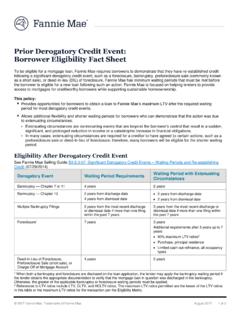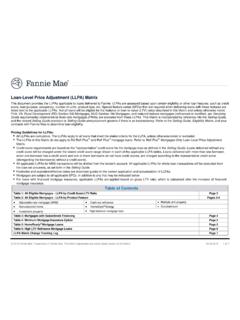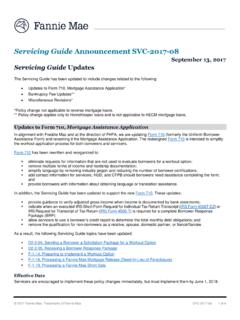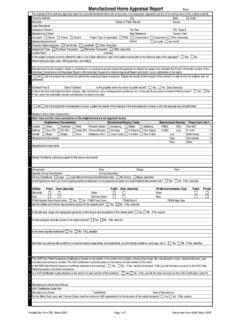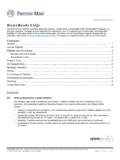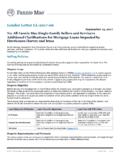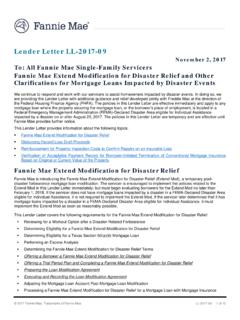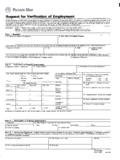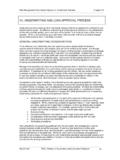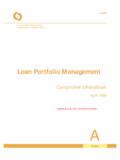Transcription of Lender Letter LL-2010-03: An Introduction to Fannie Mae's ...
1 Lender Letter LL-2010-03 February 26, 2010. To: All Fannie Mae Single-Family Sellers An Introduction to Fannie Mae's loan quality Initiative Introduction Historically, many issues related to compliance with Fannie Mae selling policies are not detected until after loans are delinquent or through the foreclosure process. loan repurchase requests to lenders have increased in the past three years, highlighting the need for an improved approach for working with lenders to deliver loans that meet Fannie Mae's underwriting and eligibility guidelines. Fannie Mae conducted an extensive analysis to determine the primary drivers of repurchase requests and is launching the loan quality Initiative (LQI) to identify and implement policy, process, and technology enhancements to improve the compliance with underwriting and eligibility guidelines and mitigate repurchase risk. Working with its Lender partners, Fannie Mae will implement the LQI enhancements to promote improved loan delivery data that is complete, accurate, and fully reflective of the terms of the mortgage.
2 The LQI will also help ensure that the loan meets the credit and eligibility standards, pricing guidelines, and other requirements of the Selling Guide or negotiated variances. A. primary focus is on capturing critical loan data earlier in the process and validating it before, during, and immediately after loan delivery. This updated approach is designed to stand the test of time across market cycles and risk tolerances, thus supporting market stability and reducing investor and Lender risk. Changes introduced under the LQI are intended to reduce repurchase requests through improved data integrity and consistent and early feedback on policy compliance while maintaining the current business model of relying on lenders to make appropriate decisions in accordance with Fannie Mae's guidelines. Over the next few months, Fannie Mae will release a number of Selling and Servicing Guide announcements and release notes ( loan Delivery and Desktop Underwriter ) that will describe the specific changes that fall under the LQI.
3 The purpose of this Lender Letter is to familiarize lenders with the changes that are coming to facilitate Lender planning and allocation of resources for the implementation. Overview The loan quality Initiative focuses on several areas, including: Lender Letter LL-2010-03 Page 1. policies that confirm the identity and occupancy of the borrower, validation of qualified parties to the transaction, and policies that address the borrower's credit profile;. updated quality control requirements for lenders and an improved feedback loop;. the delivery of additional information about the property and the appraisal;. loan delivery enhancements, including - validation of loan eligibility at delivery;. - a new capability that enables Lender validation of data before, during and immediately after loan delivery; and - collection of additional loan data at delivery and transition to an XML format.
4 Reporting and validation of mortgage insurance coverage data. Following is a description of each of the policy changes or enhancements that are planned and an indication of how and when additional information will be communicated to the Lender . Note: All references to loan delivery apply to mortgage loans delivered for whole loan purchase and to mortgage loans delivered in MBS pools. The delivery edits noted below will apply based on the date the whole loan or MBS loan data is submitted to loan Delivery. Confirmation of Borrower Identity and Occupancy, Validation of Qualified Parties, and Borrower Credit Profile Borrower Identity Verification Lenders will be required to confirm each borrower's identity prior to the extension of credit. Fannie Mae's requirements for borrower identity verification are intended to align with lenders'. existing federal obligations under laws requiring information and document verification, including the Department of Treasury's Office of Foreign Assets Control (OFAC) regulations and the Patriot Act.
5 Future Communication: Selling Guide Update and Announcement - March 2, 2010. Social Security or Tax Identification Numbers As part of the LQI, Fannie Mae will be implementing several enhancements related to Social Security numbers. Policy Change: Fannie Mae will require all borrowers to have a valid Social Security number or Individual Taxpayer Identification Number (ITIN) (in addition to meeting existing legal residency and documentation requirements). Desktop Underwriter (DU ): The existing Potential Red Flag messages pertaining to Social Security number will be changed to verification messages, which will require the Lender to take steps to verify the accuracy of the Social Security number. Delivery: Lenders will be required to provide the Social Security number or ITIN at loan delivery for up to two borrowers. Delivery of mortgage loans for borrowers without Social Security numbers or ITINs will require a variance to the Selling Guide ( , legal entity borrowers of group homes), and must be delivered under a Master Agreement for identification and tracking.
6 New Social Security number/ITIN edits will be implemented as follows: Lender Letter LL-2010-03 Page 2. Data integrity checks - format-specific, nine numeric digits, and 0 not permitted in certain positions. May 17, 2010 Warnings July 26, 2010 Edits will become fatal Validation edits - Based on information from the Social Security Administration, the number has reportedly not been issued, was issued prior to date of birth, or belongs to deceased individual. July 26, 2010 Warnings January 3, 2011 Edits will become fatal Lender Validation: For loans that do not pass the delivery edits and for loans that receive Social Security number verification messages from DU, the Lender must validate the accuracy of the Social Security number with the Social Security Administration using Form SSA-89. Upon verification, these loans must be delivered with Special Feature Code 162, indicating the Lender 's compliance with this verification requirement.
7 Additional Information: DU Release Notes February 17, 2010. Future Communication: Selling Guide Update and Announcement March 2, 2010. loan Delivery Release Notes March 2010 and May 2010. Borrower Occupancy In DU, the existing Potential Red Flag messages pertaining to borrower occupancy will be changed to verification messages, which will require the Lender to obtain documentation that confirms the borrower's intent to occupy the subject property as his or her principal residence. The Lender must determine the type of documentation that is most appropriate for the particular loan scenario. For example, if the transaction is a refinance of a principal residence but the loan application contains a different current address for the borrower, the Lender must obtain additional documentation from the borrower to justify the conflicting address information ( , a Letter of explanation and/or other documentation to support the discrepancy).
8 If the transaction is the purchase of a principal residence but a recent previous mortgage transaction was also the purchase of a principal residence, the borrower must provide some reasonable documentation to justify the new transaction. Additional Information: DU Release Notes February 17, 2010. Validation of Qualified Parties to the Transaction Fannie Mae will be implementing a new policy that prohibits lenders from delivering loans that have been originated, underwritten, or serviced by individuals or companies that are listed on the federal General Services Administration (GSA) Excluded Party list or HUD's Limited Denial of Participation list. Such individuals and companies include an individual with management or supervisory responsibilities within the seller or servicer's organization, an individual or entity with critical influence on or substantive control over the origination or servicing of a mortgage or any function related to the origination or servicing of a mortgage.
9 Future Communication: Selling Guide Update and Announcement - March 2, 2010. Lender Letter LL-2010-03 Page 3. Borrower Credit - Undisclosed Liabilities Lenders are responsible for determining that all debts incurred or closed by the borrower, up to and concurrent with settlement on the subject mortgage loan , are disclosed on the final loan application that is signed by the borrower at closing. These debts must be evaluated and included in the qualification for the subject mortgage loan . Lenders must have adequate internal controls and processes to support this requirement. Future Communication: Selling Guide Update and Announcement - March 2, 2010. quality Control Fannie Mae will be substantially rewriting Part D of the Selling Guide to include new and updated quality control policies, and reorganizing the topics to help lenders locate specific policies more efficiently. The policy changes will address prefunding quality control, sampling methodologies, reporting, and auditing.
10 The changes to the quality control requirements will provide a higher level of specificity to existing Lender requirements, update outdated policies, and align with recent Selling Guide changes. In addition, Fannie Mae will be implementing an internal feedback loop that will validate the effectiveness of the existing and new policy requirements and will identify new quality control policies to be implemented in the future. Fannie Mae will also be expanding the monitoring and assessment of the effectiveness of Lender quality control plans to provide consistent feedback to lenders on ways to improve loan quality . Future Communication: Selling Guide Update and Announcement Late March 2010. Property and Appraisal Data Identification of Property Unit Number If the subject property is a condo or other property type that is identified by a unit number, Fannie Mae will require the unit number to be reflected in the property address on the note.

